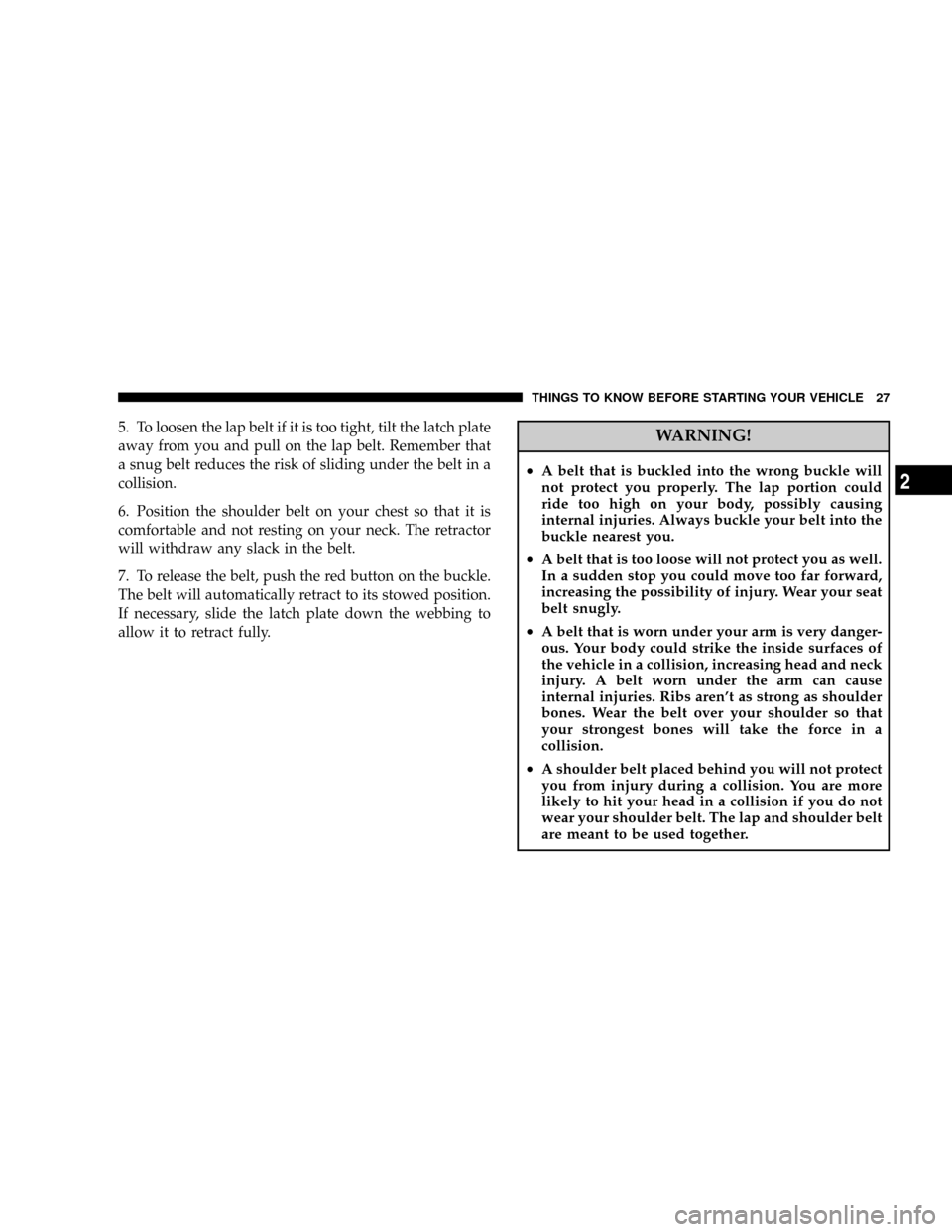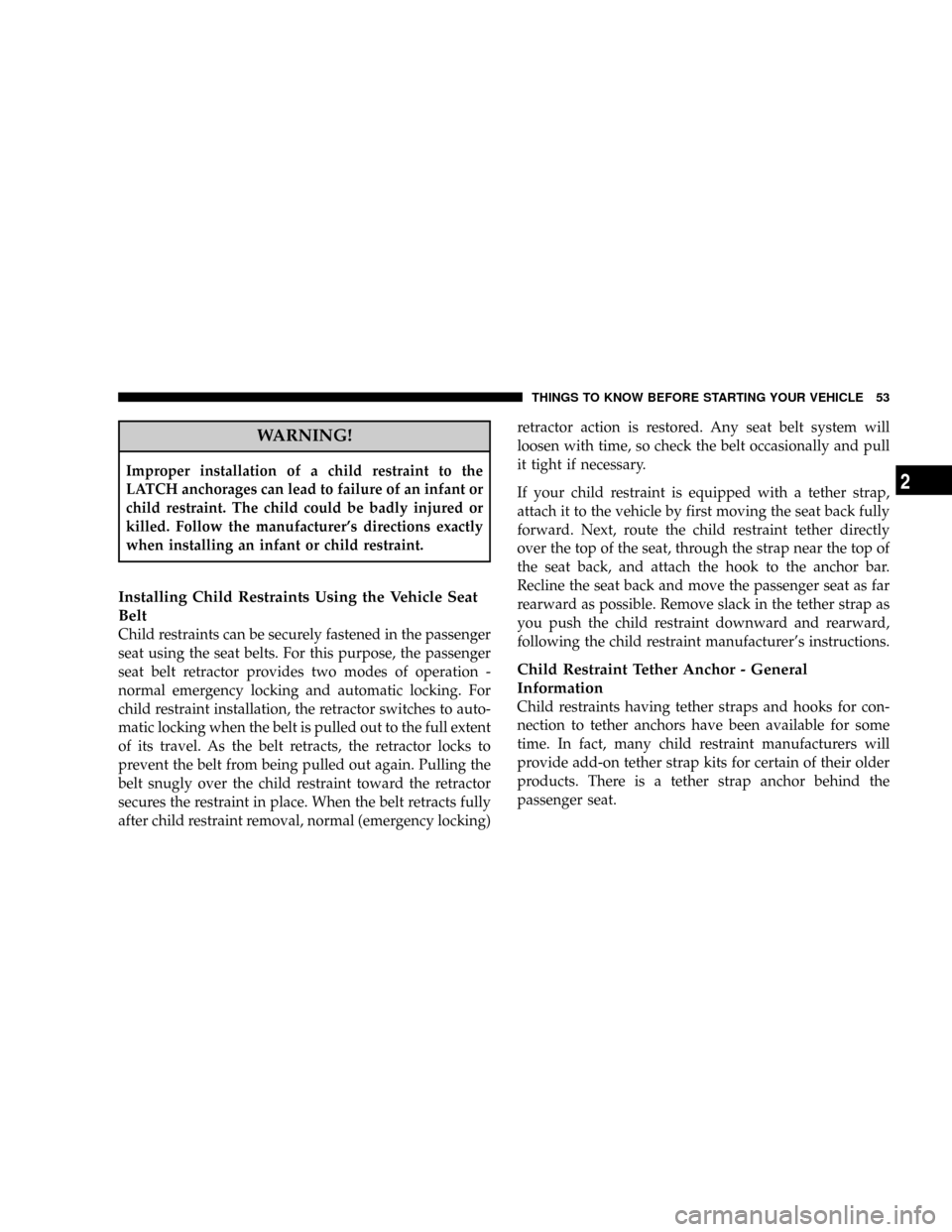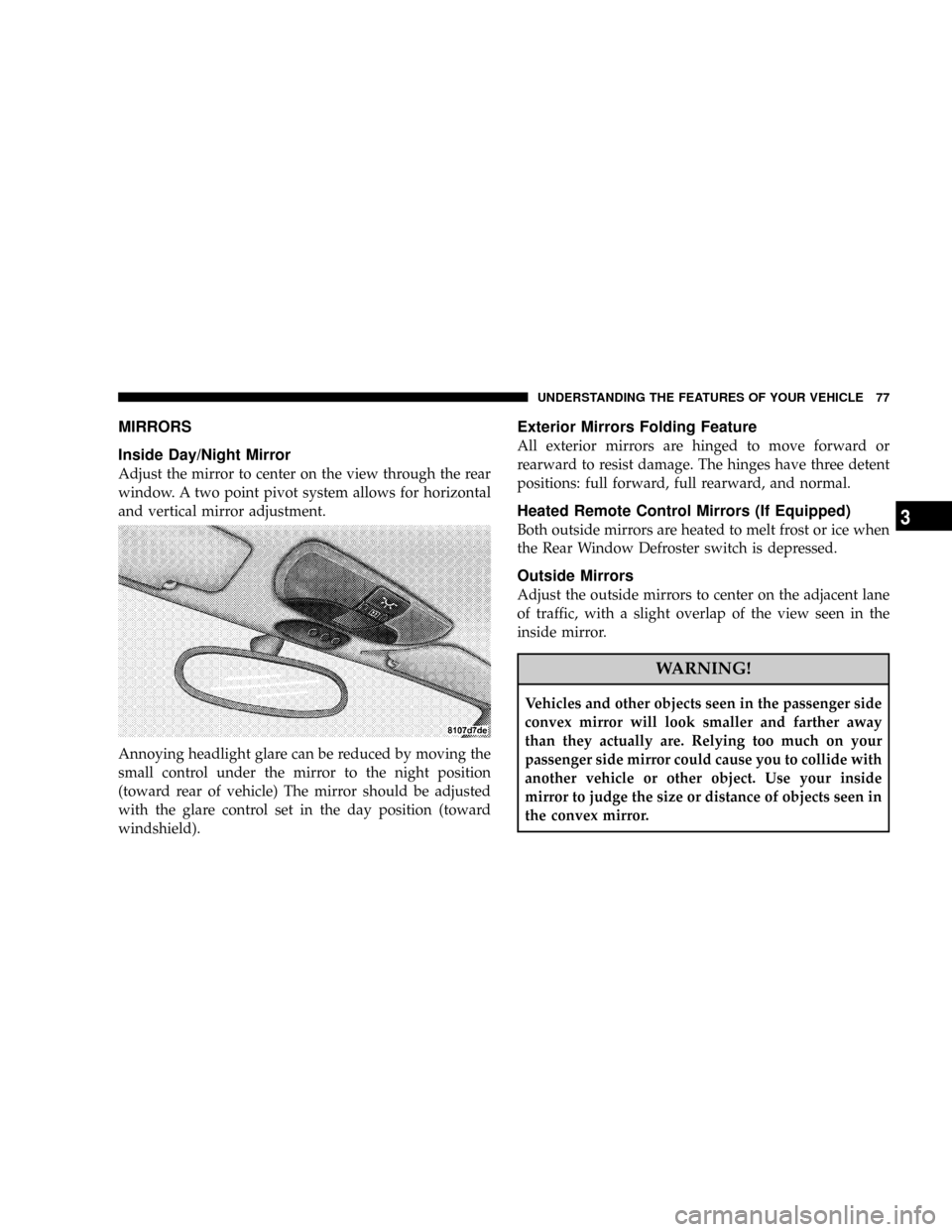tow CHRYSLER CROSSFIRE 2007 1.G Owners Manual
[x] Cancel search | Manufacturer: CHRYSLER, Model Year: 2007, Model line: CROSSFIRE, Model: CHRYSLER CROSSFIRE 2007 1.GPages: 299, PDF Size: 8.26 MB
Page 7 of 299

THINGS TO KNOW BEFORE STARTING YOUR VEHICLE
CONTENTS
mA Word About Your Keys................. 9
NKeys............................... 9
NObtaining Replacement Keys.............. 9
NIgnition Key Removal...................10
NKey-In-Ignition Reminder................10
mGlove Compartment Lock.................11
mDoor Locks...........................11
NCentral Locking Switch..................12
NAutomatic Central Locking...............13
NGeneral Notes On The Central Locking
System..............................13
NEmergency Unlocking Feature.............14NStart Lockout.........................14
mRemote Keyless Entry....................14
NTo Unlock The Doors...................15
NTo Lock The Doors.....................16
NPanic Alarm..........................17
NTo Use The Panic Alarm.................17
NGeneral Information....................17
NTransmitter Battery Service...............18
mSecurity Alarm System...................19
NTow-Away Alarm......................19
mDecklid Internal Emergency
Release - Roadster
......................20
2
Page 19 of 299

approximately 30 seconds, insert the key in the ignition
and turn it to the ON/RUN position. The remote control
should once again be operational.
SECURITY ALARM SYSTEM
The system monitors the doors, rear liftgate/decklid,
hood, and ignition for unauthorized operation. The se-
curity alarm system is automatically armed or disarmed
with the remote control or any of your vehicle's keys by
locking or unlocking the vehicle.
The antitheft alarm is armed within approximately 10
seconds after locking the vehicle. A blinking light in the
tow away alarm switch indicates that the alarm is armed.
Once the alarm system has been armed, the exterior
vehicle lights will flash and an alarm will sound when a
door, the rear liftgate/decklid, the hood, or glove com-
partment is opened, or if someone attempts to raise the
vehicle for towing. The alarm will flash the exterior
lamps for approximately three minutes and sound an
audible alarm for 30 seconds. The alarm will stay on even
if the activating element is immediately closed.
Tow-Away Alarm
The tow-away alarm switch is located on the console. To
deactivate for towing or jacking up the vehicle, press and
release the upper portion of the switch. Press and release
the upper portion to activate it again.
After the alarm system has been armed, the exterior
vehicle lights will flash and an alarm will sound when
someone attempts to raise the vehicle. The alarm will
flash the exterior lamps for approximately three minutes
and sound an audible alarm for 30 seconds. The alarm
will stay on even if the vehicle is immediately lowered.
To cancel the alarm, insert the key into the ignition switch
or press a transmit button on the key fob.
To prevent triggering the tow-away alarm feature when
parking on a surface subject to movement (such as a
ferry), switch off the tow-away alarm. To do so, turn the
key in the ignition switch to the OFF/LOCK or ACC
position, or remove the key from the ignition switch.
Press the tow-away alarm switch and the indicator light
will illuminate briefly. Exit the vehicle, and lock the
vehicle with the key or the remote control.
THINGS TO KNOW BEFORE STARTING YOUR VEHICLE 19
2
Page 20 of 299

The tow-away alarm remains switched off until the
vehicle is locked again with the key or the remote control,
at which time it is automatically reactivated.DECKLID INTERNAL EMERGENCY RELEASE -
ROADSTER
As a security measure, a Decklid Internal Emergency
Release lever is built into the decklid latching mecha-
nism. In the event of an individual being locked inside
the trunk, the decklid can be easily opened by pulling on
the glow-in-the-dark handle attached to the decklid
latching mechanism. See picture.
WARNING!
Do not allow children to have access to the trunk by
climbing into the trunk from outside. Always close
the decklid when your vehicle is unattended. Once in
the trunk, young children may not be able to escape.
If trapped in the trunk, children can die from suffo-
cation or heat stroke.
20 THINGS TO KNOW BEFORE STARTING YOUR VEHICLE
Page 27 of 299

5. To loosen the lap belt if it is too tight, tilt the latch plate
away from you and pull on the lap belt. Remember that
a snug belt reduces the risk of sliding under the belt in a
collision.
6. Position the shoulder belt on your chest so that it is
comfortable and not resting on your neck. The retractor
will withdraw any slack in the belt.
7. To release the belt, push the red button on the buckle.
The belt will automatically retract to its stowed position.
If necessary, slide the latch plate down the webbing to
allow it to retract fully.WARNING!
²A belt that is buckled into the wrong buckle will
not protect you properly. The lap portion could
ride too high on your body, possibly causing
internal injuries. Always buckle your belt into the
buckle nearest you.
²A belt that is too loose will not protect you as well.
In a sudden stop you could move too far forward,
increasing the possibility of injury. Wear your seat
belt snugly.
²A belt that is worn under your arm is very danger-
ous. Your body could strike the inside surfaces of
the vehicle in a collision, increasing head and neck
injury. A belt worn under the arm can cause
internal injuries. Ribs aren't as strong as shoulder
bones. Wear the belt over your shoulder so that
your strongest bones will take the force in a
collision.
²A shoulder belt placed behind you will not protect
you from injury during a collision. You are more
likely to hit your head in a collision if you do not
wear your shoulder belt. The lap and shoulder belt
are meant to be used together.
THINGS TO KNOW BEFORE STARTING YOUR VEHICLE 27
2
Page 43 of 299

How the Driver/Passenger Inflatable Knee
Blockers Works
When the ORC and the impact sensors detect a collision
requiring the Driver/Passenger Inflatable Knee Blockers,
it signals the inflator unit. A quantity of nontoxic gas is
generated to inflate the Driver/Passenger Inflatable Knee
Blockers. The Driver/Passenger Inflatable Knee Blockers
inflates rearward towards the driver 's knees to help
protect the knees and position you for the best interaction
with the front airbag. The Driver/Passenger Inflatable
Knee Blockers fully inflates in about 50 milliseconds, this
is only about half of the time it takes you to blink your
eyes. It then quickly deflates while helping to protect the
driver 's knees.
The Knee Impact Blockers help protect the knees and
position the occupant.
Passenger Front Airbag On/Off Switch
The ON/OFF switch is located at the right end of the
instrument panel and is accessible by opening the pas-
senger door.
NOTE:When using certain types of child seats, the
passenger airbag light will remain off even though the
passenger front airbags are disabled.
It is always recommended to turn off the passenger front
air bags using the passenger front airbags on/off switch
located at the right end of the instrument panel when the
passenger is:
²an infant (less than 1 year old),
²a child, age 1 to 12,
²an adult with a medical condition which makes pas-
senger airbag inflation (deployment) a greater risk for
the passenger than the risk of hitting the dashboard
(instrument panel) or windshield in a crash.
The on/off switch is accessible by opening the passenger
door.
THINGS TO KNOW BEFORE STARTING YOUR VEHICLE 43
2
Page 53 of 299

WARNING!
Improper installation of a child restraint to the
LATCH anchorages can lead to failure of an infant or
child restraint. The child could be badly injured or
killed. Follow the manufacturer's directions exactly
when installing an infant or child restraint.
Installing Child Restraints Using the Vehicle Seat
Belt
Child restraints can be securely fastened in the passenger
seat using the seat belts. For this purpose, the passenger
seat belt retractor provides two modes of operation -
normal emergency locking and automatic locking. For
child restraint installation, the retractor switches to auto-
matic locking when the belt is pulled out to the full extent
of its travel. As the belt retracts, the retractor locks to
prevent the belt from being pulled out again. Pulling the
belt snugly over the child restraint toward the retractor
secures the restraint in place. When the belt retracts fully
after child restraint removal, normal (emergency locking)retractor action is restored. Any seat belt system will
loosen with time, so check the belt occasionally and pull
it tight if necessary.
If your child restraint is equipped with a tether strap,
attach it to the vehicle by first moving the seat back fully
forward. Next, route the child restraint tether directly
over the top of the seat, through the strap near the top of
the seat back, and attach the hook to the anchor bar.
Recline the seat back and move the passenger seat as far
rearward as possible. Remove slack in the tether strap as
you push the child restraint downward and rearward,
following the child restraint manufacturer's instructions.
Child Restraint Tether Anchor - General
Information
Child restraints having tether straps and hooks for con-
nection to tether anchors have been available for some
time. In fact, many child restraint manufacturers will
provide add-on tether strap kits for certain of their older
products. There is a tether strap anchor behind the
passenger seat.
THINGS TO KNOW BEFORE STARTING YOUR VEHICLE 53
2
Page 64 of 299

CAUTION!
To avoid possible damage to the tonneau cover and
convertible top, do not allow the convertible top to
remain in the suspended position. After approxi-
mately 10 minutes in the suspended position, the
hydraulic pressure will be released which will allow
the top and the tonneau cover to lower. The convert-
ible top switch can be pressed to cancel this
operation.
CAUTION!
To avoid damage to either the top or the rear window,
check the tonneau cover area at the rear of the vehicle
interior to be sure that it is clear of debris or other
items. Do not use the tonneau cover area for other
storage purposes.
CAUTION!
To fully insure that no damage occurs, be sure that
the vehicle is at a complete stop before attempting to
lower or raise the top.
NOTE:If the top stops during the raising or lowering
procedure, start the engine and continue operation.
1. Make sure the rear cargo compartment divider is
unfolded and secured in the vertical position.
If the divider is in its stowed position, first unfold the
panels towards the rear of the vehicle. Pull up on the
vertical panel using the center cutout shown, and hook
the pins at the top into the brackets mounted to the cargo
compartment trim on each side near the forward edge of
the decklid opening. The pins must be hooked in these
brackets in order for the top to operate.
64 UNDERSTANDING THE FEATURES OF YOUR VEHICLE
Page 72 of 299

CONSOLE FEATURES
The console has a power outlet/cigar lighter, an ash tray
with a coin holder, a cupholder (if equipped), and the
passenger airbag light. In addition, there are switches to
control the heated seats (if equipped), rear spoiler, elec-
tronic stability program (ESP), hazard flashers, central
locking, rear defroster and towing alarm.
Operating controls for the heating and air conditioning
systems, power windows, power mirrors, convertible top
switch (if equipped), and the automatic transmission
program mode selector switch (if equipped) are also
located in the console.
72 UNDERSTANDING THE FEATURES OF YOUR VEHICLE
Page 77 of 299

MIRRORS
Inside Day/Night Mirror
Adjust the mirror to center on the view through the rear
window. A two point pivot system allows for horizontal
and vertical mirror adjustment.
Annoying headlight glare can be reduced by moving the
small control under the mirror to the night position
(toward rear of vehicle) The mirror should be adjusted
with the glare control set in the day position (toward
windshield).
Exterior Mirrors Folding Feature
All exterior mirrors are hinged to move forward or
rearward to resist damage. The hinges have three detent
positions: full forward, full rearward, and normal.
Heated Remote Control Mirrors (If Equipped)
Both outside mirrors are heated to melt frost or ice when
the Rear Window Defroster switch is depressed.
Outside Mirrors
Adjust the outside mirrors to center on the adjacent lane
of traffic, with a slight overlap of the view seen in the
inside mirror.
WARNING!
Vehicles and other objects seen in the passenger side
convex mirror will look smaller and farther away
than they actually are. Relying too much on your
passenger side mirror could cause you to collide with
another vehicle or other object. Use your inside
mirror to judge the size or distance of objects seen in
the convex mirror.
UNDERSTANDING THE FEATURES OF YOUR VEHICLE 77
3
Page 89 of 299

Headlight Dimmer Switch
Push the multifunction control lever toward the instru-
ment panel to turn the headlights to high beam. Pull the
lever toward you to switch to low beam.
UNDERSTANDING THE FEATURES OF YOUR VEHICLE 89
3